formerly eScholarship Editions


|
|
|
|
Your request for similar items found 20 book(s). | Modify Search | Displaying 1 - 20 of 20 book(s) | |
| 1. |  | Title: Sierra crossing: first roads to California Author: Howard, Thomas Frederick 1946- Published: University of California Press, 1998 Subjects: California and the West | Californian and Western History | Geography | United States History Publisher's Description: A critical era in California's history and development - the building of the first roads over the Sierra Nevada - is thoroughly and colorfully documented in Thomas Howard's fascinating book. During California's first two decades of statehood (1850-1870), the state was separated from the east coast by a sea journey of at least six weeks. Although Californians expected to be connected with the other states by railroad soon after the 1849 Gold Rush, almost twenty years elapsed before this occurred. Meanwhile, various overland road ventures were launched by "emigrants," former gold miners, state government officials, the War Department, the Interior Department, local politicians, town businessmen, stagecoach operators, and other entrepreneurs whose alliances with one another were constantly shifting. The broad landscape of international affairs is also a part of Howard's story.Constructing roads and accumulating geographic information in the Sierra Nevada reflected Washington's interest in securing the vast western territories formerly held by others. In a remarkably short time the Sierra was transformed by vigorous exploration, road-promotion, and road-building. Ox-drawn wagons gave way to stagecoaches able to provide service as fine as any in the country. Howard effectively uses diaries, letters, newspaper stories, and official reports to recreate the human struggle and excitement involved in building the first trans-Sierra roads. Some of those roads have become modern highways used by thousands every day, while others are now only dim traces in the lonely backcountry. [brief] Similar Items |
| 2. | 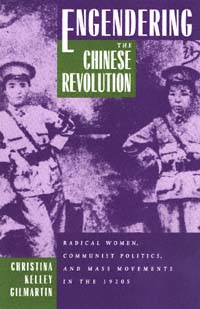 | Title: Engendering the Chinese revolution: radical women, communist politics, and mass movements in the 1920s Author: Gilmartin, Christina K Published: University of California Press, 1995 Subjects: History | Asian History | China | Women's Studies Publisher's Description: Christina Kelley Gilmartin rewrites the history of gender politics in the 1920s with this compelling assessment of the impact of feminist ideals on the Chinese Communist Party during its formative years. For the first time, Gilmartin reveals the extent to which revolutionaries in the 1920s were committed to women's emancipation and the radical political efforts that were made to overcome women's subordination and to transform gender relations.Women activists whose experiences and achievements have been previously ignored are brought to life in this study, which illustrates how the Party functioned not only as a political organization but as a subculture for women as well. We learn about the intersection of the personal and political lives of male communists and how this affected their beliefs about women's emancipation. Gilmartin depicts with thorough and incisive scholarship how the Party formulated an ideological challenge to traditional gender relations while it also preserved aspects of those relationships in its organization. [brief] Similar Items |
| 3. | 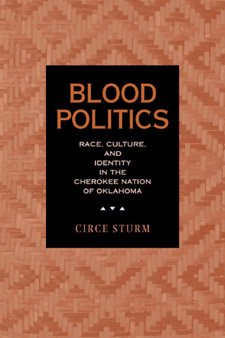 | Title: Blood politics: race, culture, and identity in the Cherokee Nation of Oklahoma Author: Sturm, Circe 1967- Published: University of California Press, 2002 Subjects: Anthropology | Cultural Anthropology | Native American Studies | Native American Ethnicity | African American Studies Publisher's Description: Circe Sturm takes a bold and original approach to one of the most highly charged and important issues in the United States today: race and national identity. Focusing on the Oklahoma Cherokee, she examines how Cherokee identity is socially and politically constructed, and how that process is embedded in ideas of blood, color, and race. Not quite a century ago, blood degree varied among Cherokee citizens from full blood to 1/256, but today the range is far greater--from full blood to 1/2048. This trend raises questions about the symbolic significance of blood and the degree to which blood connections can stretch and still carry a sense of legitimacy. It also raises questions about how much racial blending can occur before Cherokees cease to be identified as a distinct people and what danger is posed to Cherokee sovereignty if the federal government continues to identify Cherokees and other Native Americans on a racial basis. Combining contemporary ethnography and ethnohistory, Sturm's sophisticated and insightful analysis probes the intersection of race and national identity, the process of nation formation, and the dangers in linking racial and national identities. [brief] Similar Items |
| 4. |  | Title: Pilgrim stories: on and off the road to Santiago Author: Frey, Nancy Louise 1968- Published: University of California Press, 1998 Subjects: Religion | Anthropology | Christianity | European History Publisher's Description: Each year thousands of men and women from more than sixty countries journey by foot and bicycle across northern Spain, following the medieval pilgrimage road known as the Camino de Santiago. Their destination is Santiago de Compostela, where the remains of the apostle James are said to be buried. These modern-day pilgrims and the role of the pilgrimage in their lives are the subject of Nancy Louise Frey's fascinating book.Unlike the religiously-oriented pilgrims who visit Marian shrines such as Lourdes, the modern Road of St. James attracts an ecumenical mix of largely well-educated, urban middle-class participants. Eschewing comfortable methods of travel, they choose physically demanding journeys, some as long as four months, in order to experience nature, enjoy cultural and historical patrimony, renew faith, or cope with personal trauma.Frey's anthropological study focuses on the remarkable reanimation of the Road that has gained momentum since the 1980s. Her intensive fieldwork (including making the pilgrimage several times herself) provides a colorful portrayal of the pilgrimage while revealing a spectrum of hopes, discontents, and desires among its participants, many of whom feel estranged from society. The Camino's physical and mental journey offers them closer community, greater personal knowledge, and links to the past and to nature.But what happens when pilgrims return home? Exploring this crucial question Frey finds that pilgrims often reflect deeply on their lives and some make significant changes: an artistic voice is discovered, a marriage is ended, meaningful work is found. Other pilgrims repeat the pilgrimage or join a pilgrims' association to keep their connection to the Camino alive. And some only remain pilgrims while on the road. In all, Pilgrim Stories is an exceptional prism through which to understand the desires and dissatisfactions of contemporary Western life at the end of the millennium."Feet are touched, discussed, massaged, [and] become signs of a journey well traveled: 'I did it all on foot!' . . . Pilgrims give feet a power and importance not recognized in daily life, as a causeway and direct channel to the road, the past, meaningful relations, nature, and the self." [brief] Similar Items |
| 5. | 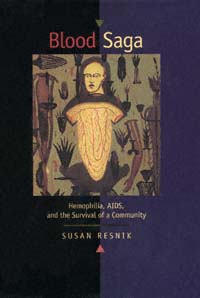 | Title: Blood saga: hemophilia, AIDS, and the survival of a community Author: Resnik, Susan 1940- Published: University of California Press, 1999 Subjects: Science | Sociology | Medicine | Anthropology Publisher's Description: For thousands of years boys known as "bleeders" faced an early, painful death from hemophilia. Dubbed "the Royal Disease" because of its identification with Queen Victoria, the world's most renowned carrier, hemophilia is a genetic disease whose sufferers had little recourse until the mid-twentieth century. In the first book to chronicle the emergence and transformation of the hemophilia community, Susan Resnik sets her story within our national political landscape - where the disease is also a social, psychological, and economic experience. Blood Saga includes many players and domains: men with hemophilia and their families, medical personnel, science researchers, and the author herself, who was Director of Education of the National Hemophilia Foundation in the early 1980s. At that time the "miracle treatment" of freeze-dried pooled plasma blood products enabled men with hemophilia to lead full, normal lives. Then the AIDS virus infiltrated the treatment system and over fifty percent of the hemophilia community became HIV-positive. But rather than collapsing, this community refocused its priorities, extended its reach, and helped shape blood safety policies to prevent further tragedy.The hemophilia community includes people from every socioeconomic and ethnic group, and Resnik's narrative and use of oral histories never lose touch with those affected by the disease. Her extensive informant interviewing allows much of this social history to be told by participants on all levels: parents, wives, nurses, doctors, government agency directors, health care providers, and many others.Gene insertion therapy now holds the promise of a cure for hemophilia in the near future. Scientific breakthroughs inevitably become intertwined with the industry and academic medical centers that govern the national health care system. And in that system, says Resnik, costs and safety are sometimes contending issues. She makes clear that the lessons learned in Blood Saga apply to all of us. [brief] Similar Items |
| 6. | 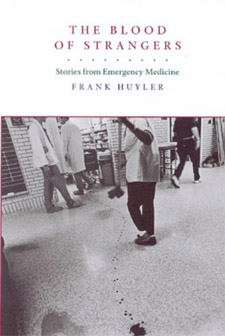 | Title: The blood of strangers: stories from emergency medicine Author: Huyler, Frank 1964- Published: University of California Press, 1999 Subjects: Medicine | American Literature | Autobiography Publisher's Description: Reminiscent of Chekhov's stories, The Blood of Strangers is a visceral portrayal of a physician's encounters with the highly charged world of an emergency room. In this collection of spare and elegant stories, Dr. Frank Huyler reveals a side of medicine where small moments - the intricacy of suturing a facial wound, the bath a patient receives from her husband and daughter - interweave with the lives and deaths of the desperately sick and injured. The author presents an array of fascinating characters, both patients and doctors - a neurosurgeon who practices witchcraft, a trauma surgeon who unexpectedly commits suicide, a wounded murderer, a man chased across the New Mexico desert by a heat-seeking missile. At times surreal, at times lyrical, at times brutal and terrifying, The Blood of Strangers is a literary work that emerges from one of the most dramatic specialties of modern medicine. This deeply affecting first book has been described by one early reader as "the best doctor collection I have seen since William Carlos Williams's The Doctor Stories ." [brief] Similar Items |
| 7. | 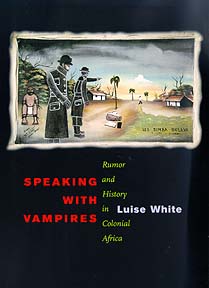 | Title: Speaking with vampires: rumor and history in colonial Africa Author: White, Luise Published: University of California Press, 2000 Subjects: African Studies | African History | African Studies | Cultural Anthropology Publisher's Description: During the colonial period, Africans told each other terrifying rumors that Africans who worked for white colonists captured unwary residents and took their blood. In colonial Tanganyika, for example, Africans were said to be captured by these agents of colonialism and hung upside down, their throats cut so their blood drained into huge buckets. In Kampala, the police were said to abduct Africans and keep them in pits, where their blood was sucked. Luise White presents and interprets vampire stories from East and Central Africa as a way of understanding the world as the storytellers did. Using gossip and rumor as historical sources in their own right, she assesses the place of such evidence, oral and written, in historical reconstruction. White conducted more than 130 interviews for this book and did research in Kenya, Uganda, and Zambia. In addition to presenting powerful, vivid stories that Africans told to describe colonial power, the book presents an original epistemological inquiry into the nature of historical truth and memory, and into their relationship to the writing of history. [brief] Similar Items |
| 8. | 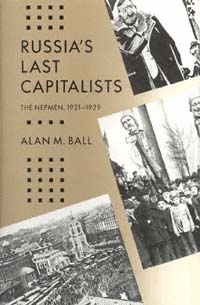 | Title: Russia's last capitalists: the Nepmen, 1921-1929 Author: Ball, Alan M Published: University of California Press, 1990 Subjects: History | European History | Russian and Eastern European Studies Publisher's Description: In 1921 Lenin surprised foreign observers and many in his own Party, by calling for the legalization of private trade and manufacturing. Within a matter of months, this New Economic Policy (NEP) spawned many thousands of private entrepreneurs, dubbed Nepmen. After delineating this political background, Alan Ball turns his attention to the Nepmen themselves, examining where they came from, how they fared in competition with the socialist sector of the economy, their importance in the Soviet economy, and the consequences of their "liquidation" at the end of the 1920s. Alan Ball's history of this experiment with capitalism is strikingly relevant to current efforts toward economic reform in the USSR. [brief] Similar Items |
| 9. | 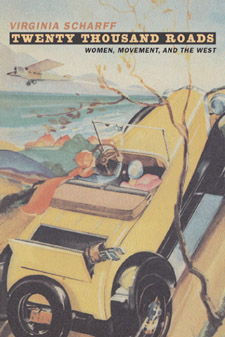 | Title: Twenty thousand roads: women, movement, and the West Author: Scharff, Virginia Published: University of California Press, 2002 Subjects: History | Women's Studies | California and the West Publisher's Description: From Sacagawea's travels with Lewis and Clark to rock groupie Pamela Des Barres's California trips, women have moved across the American West with profound consequences for the people and places they encounter. Virginia Scharff revisits a grand theme of United States history - our restless, relentless westward movement--but sets out in new directions, following women's trails from the early nineteenth to the late twentieth centuries. In colorful, spirited stories, she weaves a lyrical reconsideration of the processes that created, gave meaning to, and ultimately shattered the West. Twenty Thousand Roads introduces a cast of women mapping the world on their own terms, often crossing political and cultural boundaries defined by male-dominated institutions and perceptions. Scharff examines the faint traces left by Sacagawea and revisits Susan Magoffin's famed honeymoon journey down the Santa Fe Trail. We also meet educated women like historian Grace Hebard and government extension agent Fabiola Cabeza de Baca, who mapped the West with different voyages and visions. Scharff introduces women whose lives gave shape to the forces of gender, race, region, and modernity; participants in exploration, war, politics, empire, and struggles for social justice; and movers and shakers of everyday family life. This book powerfully and poetically shows us that to understand the American West, we must examine the lives of women who both built and resisted American expansion. Scharff remaps western history as she reveals how moving women have shaped our past, present, and future. [brief] Similar Items |
| 10. |  | Title: Weimar surfaces: urban visual culture in 1920s Germany Author: Ward, Janet 1963- Published: University of California Press, 2001 Subjects: Literature | Architecture | Film | European Studies | European History | Popular Culture Publisher's Description: Germany of the 1920s offers a stunning moment in modernity, a time when surface values first became determinants of taste, activity, and occupation: modernity was still modern, spectacle was still spectacular. Janet Ward's luminous study revisits Weimar Germany via the lens of metropolitan visual cu . . . [more] Similar Items |
| 11. | 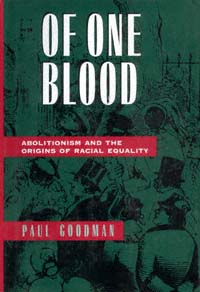 | Title: Of one blood: abolitionism and the origins of racial equality Author: Goodman, Paul 1934- Published: University of California Press, 1998 Subjects: History | United States History | American Studies Publisher's Description: The abolition movement is perhaps the most salient example of the struggle the United States has faced in its long and complex confrontation with the issue of race. In his final book, historian Paul Goodman, who died in 1995, presents a new and important interpretation of abolitionism. Goodman pays particular attention to the role that blacks played in the movement. In the half-century following the American Revolution, a sizable free black population emerged, the result of state-sponsored emancipation in the North and individual manumission in the slave states. At the same time, a white movement took shape, in the form of the American Colonization Society, that proposed to solve the slavery question by sending the emancipated blacks to Africa and making Liberia an American "colony." The resistance of northern free blacks was instrumental in exposing the racist ideology underlying colonization and inspiring early white abolitionists to attack slavery straight on. In a society suffused with racism, says Goodman, abolitionism stood apart by its embrace of racial equality as a Christian imperative.Goodman demonstrates that the abolitionist movement had a far broader social basis than was previously thought. Drawing on census and town records, his portraits of abolitionists reveal the many contributions of ordinary citizens, especially laborers and women long overshadowed by famous movement leaders. Paul Goodman's humane spirit informs these pages. His book is a scholarly legacy that will enrich the history of antebellum race and reform movements for years to come."[God] hath made of one blood all nations of men for to dwell on all the face of the earth." - Acts 17:26 [brief] Similar Items |
| 12. |  | Title: From friend to comrade: the founding of the Chinese Communist Party, 1920-1927 Author: Van de Ven, Hans J Published: University of California Press, 1992 Subjects: History | China | Politics Publisher's Description: Scholars have long held that the Chinese Communist Party (CCP) was a centralized organization from its founding in 1921. In a departure from that view, From Friend to Comrade demonstrates how the CCP began as a group of study societies, only evolving into a mass Marxist-Leninist party by 1927.Hans J. van de Ven's study is based on party documents of the 1920s that have only recently become available, as well as the writings of a wide range of Chinese communists. He analyzes the party's difficulty in building a cohesive organization firmly rooted in Chinese society. While past scholarship has emphasized the influence of Soviet communism on the CCP, van de Ven stresses the thinking and actions of Chinese communists themselves, placing their struggle in the context of China's political history and highly complex society. [brief] Similar Items |
| 13. | 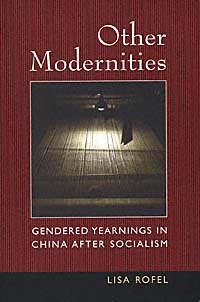 | Title: Other modernities: gendered yearnings in China after socialism Author: Rofel, Lisa 1953- Published: University of California Press, 1999 Subjects: Anthropology | Asian Studies | China | Cultural Anthropology | Women's Studies Publisher's Description: In this analysis of three generations of women in a Chinese silk factory, Lisa Rofel brilliantly interweaves the intimate details of her observations with a broad-ranging critique of the meaning of modernity in a postmodern age.The author based her study at a silk factory in the city of Hangzhou in eastern China. She compares the lives of three generations of women workers: those who entered the factory right around the Communist revolution in 1949, those who were youths during the Cultural Revolution of the 1970s, and those who have come of age in the Deng era. Exploring attitudes toward work, marriage, society, and culture, she convincingly connects the changing meanings of the modern in official discourse to the stories women tell about themselves and what they make of their lives.One of the first studies to take up theoretically sophisticated issues about gender, modernity, and power based on a solid ethnographic ground, this much-needed cross-generational study will be a model for future anthropological work around the world. [brief] Similar Items |
| 14. | 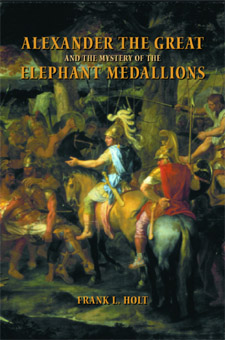 | Title: Alexander the Great and the mystery of the elephant medallions Author: Holt, Frank Lee Published: University of California Press, 2003 Subjects: Classics | Classical History | Ancient History | Military History | Art and Architecture Publisher's Description: To all those who witnessed his extraordinary conquests, from Albania to India, Alexander the Great appeared invincible. How Alexander himself promoted this appearance - how he abetted the belief that he enjoyed divine favor and commanded even the forces of nature against his enemies - is the subject of Frank L. Holt's absorbing book. Solid evidence for the "supernaturalized" Alexander lies in a rare series of medallions that depict the triumphant young king at war against the elephants, archers, and chariots of Rajah Porus of India at the Battle of the Hydaspes River. Recovered from Afghanistan and Iraq in sensational and sometimes perilous circumstances, these ancient artifacts have long animated the modern historical debate about Alexander. Holt's book, the first devoted to the mystery of these ancient medallions, takes us into the history of their discovery and interpretation, into the knowable facts of their manufacture and meaning, and, ultimately, into the king's own psyche and his frightening theology of war. The result is a valuable analysis of Alexander history and myth, a vivid account of numismatics, and a spellbinding look into the age-old mechanics of megalomania. [brief] Similar Items |
| 15. | 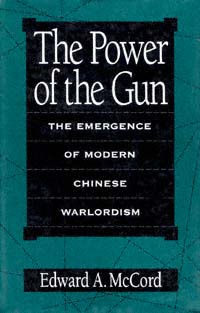 | Title: The power of the gun: the emergence of modern Chinese warlordism Author: McCord, Edward Allen Published: University of California Press, 1993 Subjects: History | Politics | Asian History | China Publisher's Description: This detailed study offers a new interpretation of the emergence of warlordism in early twentieth-century China. Focusing on the provinces of Hunan and Hubei, Edward McCord shows how the repeated use of the military to settle disputes over the structure and allocation of political power in the early Republic ultimately thwarted the consolidation of civil authority. Warlordism flourished as military commanders took advantage of the growing militarization of politics to establish their dominance over early Republican government.McCord's study brings into sharp focus the social and political context of warlordism and is an essential bridge completing the narrative of events between two revolutionary eras. With the role of the military in modern Chinese politics receiving renewed attention today, this work is especially timely. [brief] Similar Items |
| 16. | 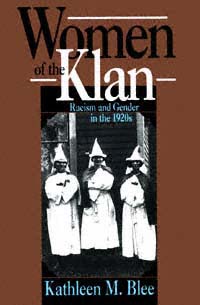 | Title: Women of the Klan: racism and gender in the 1920s Author: Blee, Kathleen M Published: University of California Press, 1992 Subjects: History | Sociology | Women's Studies | United States History | American Studies Publisher's Description: Ignorant. Brutal. Male. One of these stereotypes of the Ku Klux Klan offer a misleading picture. In Women of the Klan , sociologist Kathleen Blee unveils an accurate portrait of a racist movement that appealed to ordinary people throughout the country. In so doing, she dismantles the popular notion that politically involved women are always inspired by pacifism, equality, and justice."All the better people," a former Klanswoman assures us, were in the Klan. During the 1920s, perhaps half a million white native-born Protestant women joined the Women's Ku Klux Klan (WKKK). Like their male counterparts, Klanswomen held reactionary views on race, nationality, and religion. But their perspectives on gender roles were often progressive. The Klan publicly asserted that a women's order could safeguard women's suffrage and expand their other legal rights. Privately the WKKK was working to preserve white Protestant supremacy.Blee draws from extensive archival research and interviews with former Klan members and victims to underscore the complexity of extremist right-wing political movements. Issues of women's rights, she argues, do not fit comfortably into the standard dichotomies of "progressive" and "reactionary." These need to be replaced by a more complete understanding of how gender politics are related to the politics of race, religion, and class. [brief] Similar Items |
| 17. | 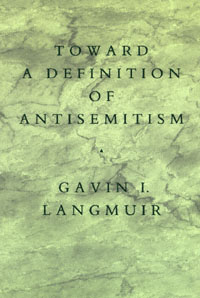 | Title: Toward a definition of antisemitism Author: Langmuir, Gavin I Published: University of California Press, 1996 Subjects: History | Medieval History | Judaism Publisher's Description: Toward a Definition of Antisemitism offers new contributions by Gavin I. Langmuir to the history of antisemitism, together with some that have been published separately. The collection makes Langmuir's innovative work on the subject available to scholars in medieval and Jewish history and religious studies. The underlying question that unites the book is: what is antisemitism, where and when did it emerge, and why? After two chapters that highlight the failure of historians until recently to depict Jews and attitudes toward them fairly, the majority of the chapters are historical studies of crucial developments in the legal status of Jews and in beliefs about them during the Middle Ages. Two concluding chapters provide an overview. In the first, the author summarizes the historical developments, indicating concretely when and where antisemitism as he defines it emerged. In the second, Langmuir criticizes recent theories about prejudice and racism and develops his own general theory about the nature and dynamics of antisemitism. [brief] Similar Items |
| 18. | 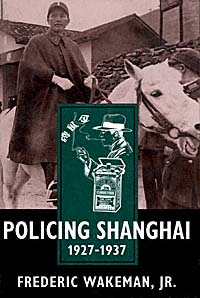 | Title: Policing Shanghai, 1927-1937 Author: Wakeman, Frederic E Published: University of California Press, 1996 Subjects: History | Asian History | China | Urban Studies | Criminology Publisher's Description: Prewar Shanghai: casinos, brothels, Green Gang racketeers, narcotics syndicates, gun-runners, underground Communist assassins, Comitern secret agents. Frederic Wakeman's masterful study of the most colorful and corrupt city in the world at the time provides a panoramic view of the confrontation and collaboration between the Nationalist secret police and the Shanghai underworld.In detailing the life and politics of China's largest urban center during the Guomindang era, Wakeman covers an array of topics: the puritanical social controls implemented by the police; the regional differences that surfaced among Shanghai's Chinese, the influence of imperialism and Western-trained officials. Parts of this book read like a spy novel, with secret police, torture, assassination; and power struggles among the French, International Settlement, and Japanese consular police within Shanghai.Chiang Kai-shek wanted to prove that the Chinese could rule Shanghai and the country by themselves, rather than be exploited and dominated by foreign powers. His efforts to reclaim the crime-ridden city failed, partly because of the outbreak of war with Japan in 1937, but also because the Nationalist police force was itself corrupted by the city.Wakeman's exhaustively researched study is a major contribution to the study of the Nationalist regime and to modern Chinese urban history. It also shows that twentieth-century China has not been characterized by discontinuity, because autocratic government - whether Nationalist or Communist - has prevailed. [brief] Similar Items |
| 19. | 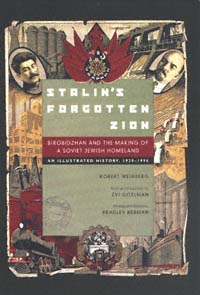 | Title: Stalin's forgotten Zion: Birobidzhan and the making of a Soviet Jewish homeland: an illustrated history, 1928-1996 Author: Weinberg, Robert E Published: University of California Press, 1998 Subjects: Jewish Studies | Russian and Eastern European Studies | History | Politics | Judaism Publisher's Description: Robert Weinberg and Bradley Berman's carefully documented and extensively illustrated book explores the Soviet government's failed experiment to create a socialist Jewish homeland. In 1934 an area popularly known as Birobidzhan, a sparsely populated region along the Sino-Soviet border some five thousand miles east of Moscow, was designated the national homeland of Soviet Jewry. Establishing the Jewish Autonomous Region was part of the Kremlin's plan to create an enclave where secular Jewish culture rooted in Yiddish and socialism could serve as an alternative to Palestine. The Kremlin also considered the region a solution to various perceived problems besetting Soviet Jews. Birobidzhan still exists today, but despite its continued official status Jews are a small minority of the inhabitants of the region. Drawing upon documents from archives in Moscow and Birobidzhan, as well as photograph collections never seen outside Birobidzhan, Weinberg's story of the Soviet Zion sheds new light on a host of important historical and contemporary issues regarding Jewish identity, community, and culture. Given the persistence of the "Jewish question" in Russia, the history of Birobidzhan provides an unusual point of entry into examining the fate of Soviet Jewry under communist rule. [brief] Similar Items |
| 20. | 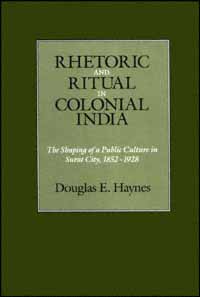 | Title: Rhetoric and ritual in colonial India: the shaping of a public culture in Surat City, 1852-1928 Author: Haynes, Douglas E Published: University of California Press, 1991 Subjects: History | Asian History | South Asia | Cultural Anthropology Publisher's Description: This book explores the rhetoric and ritual of Indian elites undercolonialism, focusing on the city of Surat in the Bombay Presidency. It particularly examines how local elites appropriated and modified the liberal representative discourse of Britain and thus fashioned a "public' culture that excluded the city's underclasses. Departing from traditional explanations that have seen this process as resulting from English education or radical transformations in society, Haynes emphasizes the importance of the unequal power relationship between the British and those Indians who struggled for political influence and justice within the colonial framework. A major contribution of the book is Haynes' analysis of the emergence and ultimate failure of Ghandian cultural meanings in Indian politics after 1923.The book addresses issues of importance to historians and anthropologists of India, to political scientists seeking to understand the origins of democracy in the "Third World," and general readers interested in comprehending processes of cultural change in colonial contexts. [brief] Similar Items |